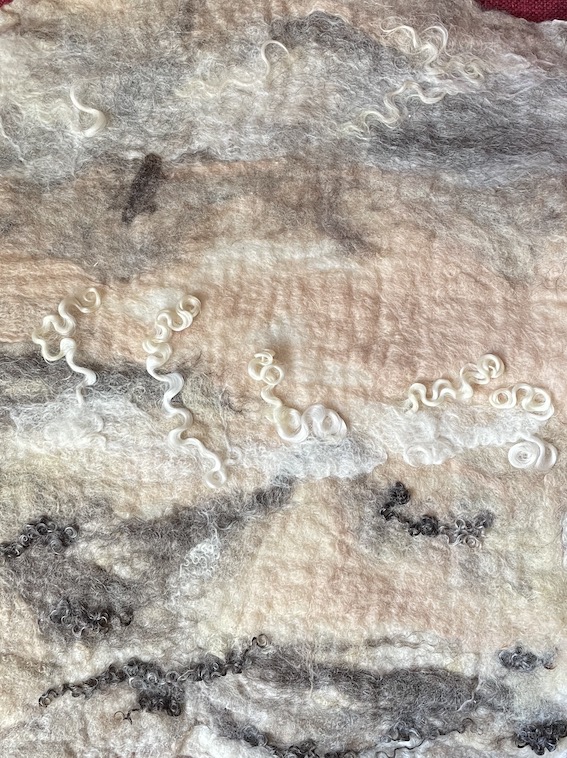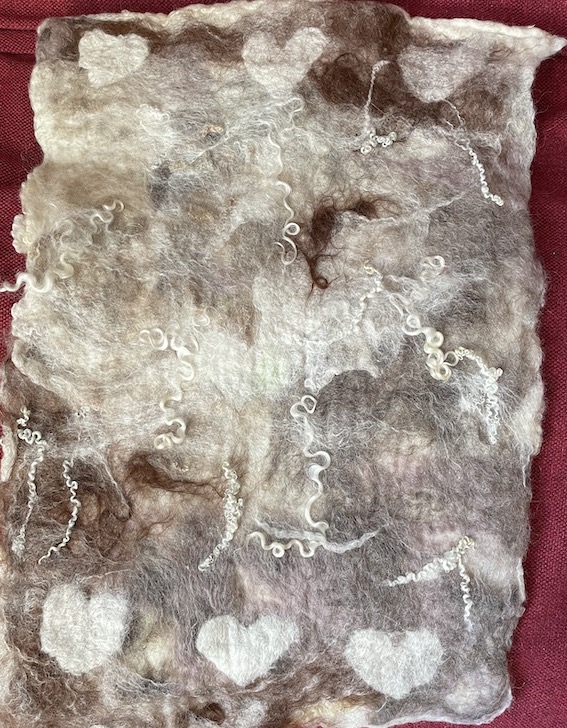Previously, I’ve blogged about making felt seats from merino wool. Although this project works a treat and seats lasted many years, I really wanted to do the whole thing from scratch with the wool gathering malarky and all that entailed. Many children rarely get the chance to gather a product from the wild and turn it into something useful or that has meaning to them. In these times, the need for children to make connections with the world around them is more important than ever. Doing a wool project is an opportunity not to be missed.
One May I went for a walk in the Pentland hills. Early summer is a good time to look for wool, as sheep begin to shed their coats.
If you look closely at the flecks in the foreground, you’ll see that they are not cotton grass or another plant, but tufts of wool!

Thus gathering wool is fairly straightforward. The only thing to remember is that it seems to love getting attached to nettles, thistles and sheep droppings. Ow! Ouch! Er!
To my delight, a friend who lives on a farm had acquired a flock of soay sheep earlier that year. My felting dreams were realised at last! The white wool gathered above is unlikely to felt well owing to its long, coarse fibres. By contrast, soay wool is ideal. These sheep do not need shearing. Their wool is shed naturally. Soay sheep are a traditional Scottish heritage breed that originally came from St Kilda and have beautiful brown fleece in a dazzling array of shades…
Once the wool has been collected, it needs to be picked over. This means removing all the bits of grass, muck, twigs and other debris gathered. The soay wool on the left has not been picked over. The wool on the right looks much cleaner. It hasn’t been washed – the wool comes in a variety of colours.
In the photo below you can see the different between the black-face sheep with the long white wool fibres compared to the more fluffy soay wool.

There is some debate as to whether the picked over wool should be washed before carding. This will remove the finer grains of dirt and lanolin, which is the wool fat that keeps the wool waterproof. As I wanted to make outdoor seats, which will be used in all weathers and get quite mucky, I decided to card the wool without washing it. The felting process uses soap so the seat does end up clean.

Although I did this indoors, it’s a messy job better suited to being outside. The scraps of wool fly everywhere and flecks of dirt drop out coating everything with fine dark dust! It goes for the throat so outdoors is the way to go (yes I learn experimentally).
I added some white wool to my felting experiment. On the right hand side is merino wool which is a commercially bought product. On the left is some beautiful curly blue-faced leicester wool that has been washed.

So after a lot of carding, layering, rolling and kneading (see this post for instructions), I finally had a felt mat that looked like this…
This is such a simple outdoor textile project for children and adults of all ages. At the moment, fleeces are very cheap and many farmers will freely donate the wool. This is one of many possible wool projects – please do share your own woolly ideas and activities.

Remember to follow good hygiene practices, such as:
- Washing hands after handling the wool and before eating food
- Using gloves if picking over gathered or donated wool
- Working outside, to avoid ingesting the finer fibres
- Checking that no-one has an allergy to wool in advance
- Anything else that you know would matter to you or the people you work with.

This post was originally published in August 2011. Very sadly after making this lovely mat, I had the not very bright idea of machine washing it. As a result I managed to ruin it. Much of my felting has been learned experientially over the years. Sigh! However I have continued to wet felt and the final two photos are example of my natural wool seats which are great for using outdoors.




















What a fabulous nature craft!!! Makes going for a long walk with your children all the more fun! I can just hear the excitement when they find more wool. Love it!
Maggy
GLORIOUS!!!
Beautttttiful!!!!
Splendiforous!
LOVE IT!
Two thumbs way up!!
I have several words to say about this. Wonderful! Magnificent! Amazing! Fantastic! Supurb! Great! Ingenious! Remarkable! Unique! Wow! Super! Lovely! Beautiful! Clever!…….& so on
Thanks for your comments. I think working with wool has lots of untapped potential world-wide 🙂 I’m planning a few more posts as my mum has just given me a couple of fleeces – one’s an amazing Jacobs sheep. The other is a bit of a mystery…
Hi Juliet, I´ve just come across this post today. I too have been collecting fleece from the Pentland Hills. I´ve washed and spun it into bookmarks. You´re right about the worldwide potential of wool. Let´s hope we see wool become a more valuable commodity with a wide variety of uses very soon!
That sounds amazing Lynne – thanks for sharing. I have been wet felting a lot recently and wool is special. It’s part of our heritage going back for centuries and is so over looked for art, craft, technology and fun in our curriculum.